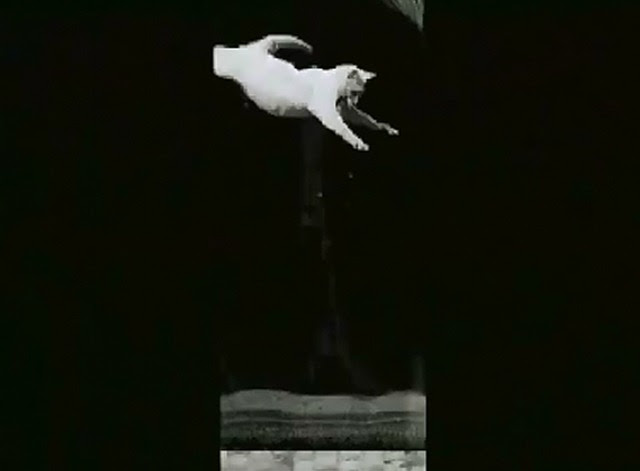
Above is a frame from a movie Étienne-Jules Marey made. He took photographs of a cat falling, in 1894. This was a scientific enterprise, designed to solve the riddle of the cat righting reflex. Marey (March 5, 1830 to May 21, 1904) used chronophotography (the technology by which many photographs could be taken quickly) to explain how the cat landed on its feet. Here are more of the frames.
[T]he French scientist and photographer Étienne-Jules Marey ...in 1894 created a series of images from which he was able to make some important deductions. The images pictured ... captured at 12 frames per second, debunked the idea that the cat was using the dropper’s hand as a fulcrum in order to begin the motion of turning at the beginning of the fall. Rather, the pictures showed that the cat had no rotational motion at the start of its descent and so was somehow acquiring angular momentum while in free-fall. Marey published these pictures, and his investigations, in an 1894 issue of Comptes Rendus, with a summary of his findings published in the journal Nature in the same year. The latter summarises Marey’s thoughts as follows:
M. Marey thinks that it is the inertia of its own mass that the cat uses to right itself. The torsion couple which produces the action of the muscles of the vertebra acts at first on the forelegs, which have a very small motion of inertia on account of the front feet being foreshortened and pressed against the neck. The hind legs, however, being stretched out and almost perpendicular to the axis of the body, possesses a moment of inertia which opposes motion in the opposite direction to that which the torsion couple tends to produce. In the second phase of the action, the attitude of the feet is reversed, and it is the inertia of the forepart that furnishes a fulcrum for the rotation of the rear.
In a rather humorous turn the author of the article also states that “The expression of offended dignity shown by the cat at the end of the first series indicates a want of interest in scientific investigation.”
M. Marey thinks that it is the inertia of its own mass that the cat uses to right itself. The torsion couple which produces the action of the muscles of the vertebra acts at first on the forelegs, which have a very small motion of inertia on account of the front feet being foreshortened and pressed against the neck. The hind legs, however, being stretched out and almost perpendicular to the axis of the body, possesses a moment of inertia which opposes motion in the opposite direction to that which the torsion couple tends to produce. In the second phase of the action, the attitude of the feet is reversed, and it is the inertia of the forepart that furnishes a fulcrum for the rotation of the rear.
In a rather humorous turn the author of the article also states that “The expression of offended dignity shown by the cat at the end of the first series indicates a want of interest in scientific investigation.”

No comments:
Post a Comment